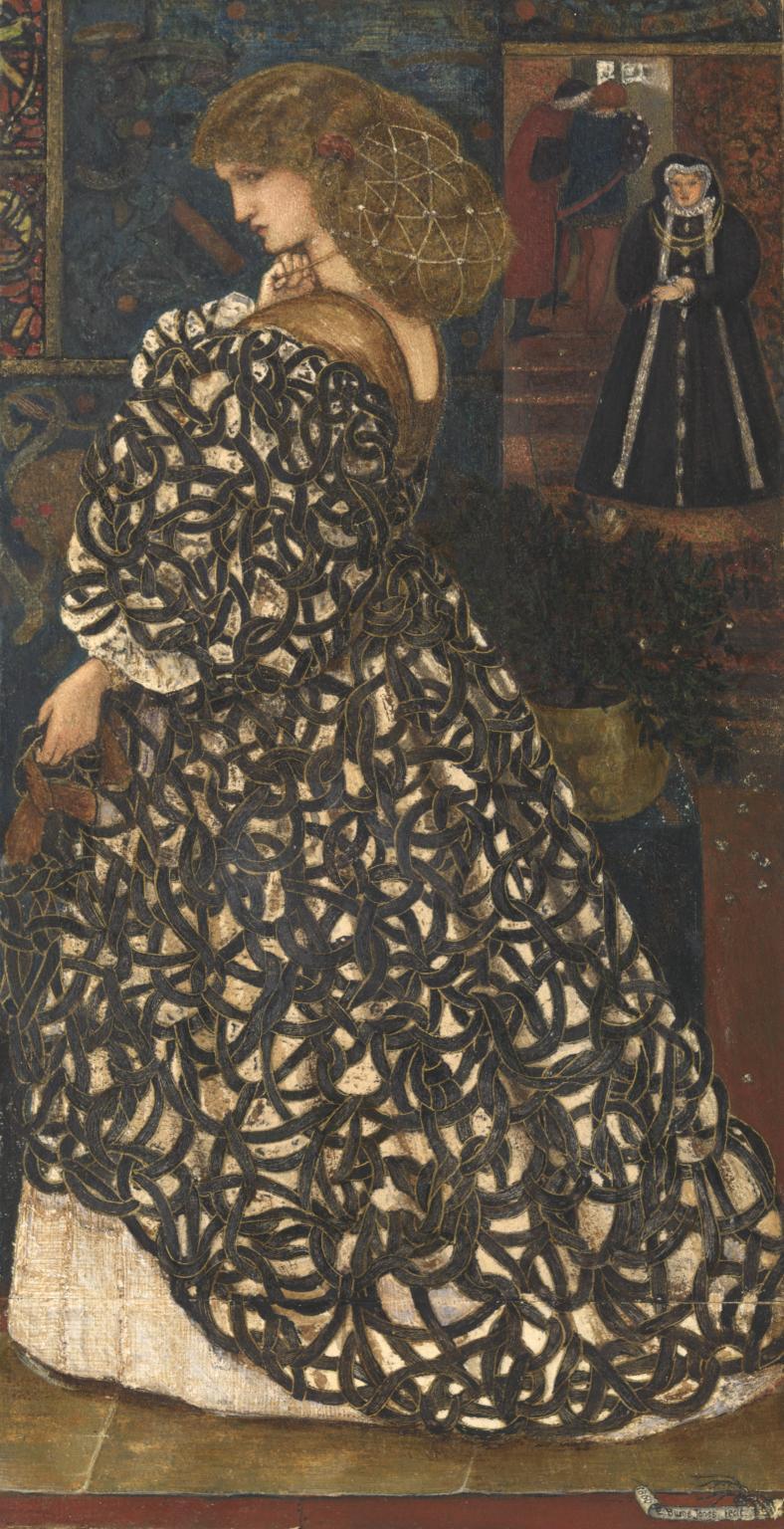Sidonia van Burke is a watercolor and gouache on paper painting created in 1860 by Sir Edward Burne-Jones, an artist of the Pre-Raphaelite circle. The painting focuses on the portrayal of Sidonia von Bork, a Pomerian noblewoman executed for witchcraft, as described by the story Sidonia von Bork: Die Klosterhexe (Sidonia the Sorceress) by Wilhelm Meinhold.
Sidonia von Bork was the daughter of a noble family, which Burn-Jones depicts through details in Sidonia’s attire. Her extravagant dress implies her upper-class status. The webbing detail gave the dress an expensive look that middle class and lower-class women would have been unable to afford. Additionally, she wears a hairnet adorned with jewels, implying that she is able to afford luxurious items. Sidonia is also depicted wearing a gold necklace. In the Victorian era, necklaces were worn by women to show that they were wealthy enough to afford such luxuries.
Along with depicting her upper-class background, Burn-Jones represents her evil nature through the design of her dress. In the 1860s, most women wore dresses with vibrant colors–such as purple, blue, and green–due to the creation of aniline dyes. (Shrimpton 14). In contrast, Sidonia’s dress has darker, earth tones, setting her apart from the virtuous natures of other women of the time. In addition, the dress displays an intricate design of entangled black webbing, representing the web of lies and coercion Sidonia created. In the book, Sidonia attracted a number of noble men with her beauty, only to treat them poorly in return. Her notoriety arose from her role in the fall of the House of Pomerania, which she enacted through the bewitchment of the entire house to end the bloodline by rendering its members dead or infertile. (McCarthy, 121). Her association with the infertility of the ruling family led to her accusation of witchcraft. The entanglement of lies represented by her dress is further supported by the spider in the bottom left corner of the painting.
The background also represents von Bork’s involvement in the fall of the House of Pomerania. Sidonia is pictured in the court of the Duchess of Wolgast. She has her back turned to a woman in the background depicting the Duchess of Wolgast. Brune-Jones depicts the Duchess in her mourning attire, which consisted of matte velvet and silk fabrics, to indicate that she is mourning the death at her husband (Shrimpton 92). The duchess’s fixation on Sidonia further suggests that she is seen as a suspect in the murder. The details of the courtroom also represent different aspects of the murders. Sidonia’s presence in a primarily dark blue represents her cold nature. The three other characters depicted in the painting inhabit a red room. Red can be used as a symbol for blood, hinting that all three will be Sidonia’s victims in the future, as this court inquiry was only the first.
In addition to symbolizing her lies, the spider also represents Sidonia’s predatory nature. Sidonia attracted her prey through her seductive nature, causing them to become trapped. Sidonia, like the spider in the bottom left corner, waited for the right moment to attack her victim. In the painting, Sidonia’s scheming expression and her orientation away from the Duchess of Wolgast indicates that she is developing a plot to kill the duchess for raising an inquiry about her in court.
Sidonia’s reputation as a seductive woman is also represented through her hairstyle. In the Pre-Raphaelite Circle aesthetic, long, kinky hair is seen as a symbol of sexuality. Sidonia’s hair has this characteristic; however, it is encompassed by a hairnet. By keeping the true nature of her hair hidden, the hair net implies Sidonia’s ability to hide her sexual and evil natures. Furthermore, the jewels that adorn the hairnet symbolize that her upper-class status protected her from repercussions and judgement that normally befell prostitutes and other fallen women.
While the scene is set prior to her death, Burne-Jones uses Sidonia’s necklace and gesture to allude to her eventual demise. Pulling a necklace often creates a sense of tension on the neck. In this case, this foreshadows that her death will involve pressure to her neck. In the story, Sidonia is charged with witchcraft and beheaded and later burned.
Edward Burne-Jones represented the evil nature and deeds of Sidonia von Bork parallel to her description in Sidonia von Bork: Die Klosterhexe. Despite depicting her in a single scene from the story, Burnes- Jones represents future events, along with Sidonia’s true nature, through his use of symbolism and color.
Resources
MacCarthy, Fiona. “The Last Pre-Raphaelite Edward Burne-Jones and the Victoiran Imagination.” Cambridge, Harvard University Press, 2012.
Shrimpton, Jayne. “Victorian Fashion.” Oxford, Shire, 2016.
Image
Burne-Jones, Edward. “Sidonia von Bork.” Watercolor and Gouache on Paper. Tate. https://www.tate.org.uk/art/images/work/N/N05/N05877_10.jpg Accessed 23 Oct 2020


